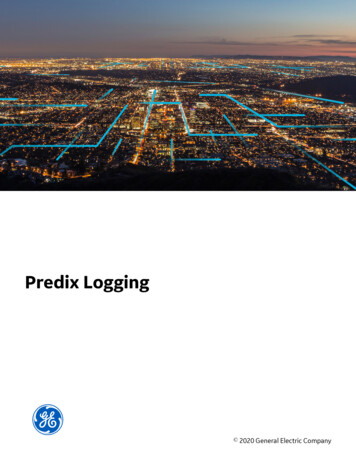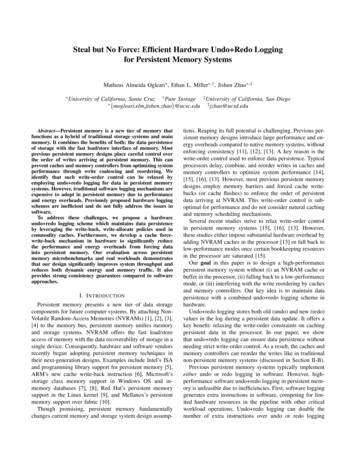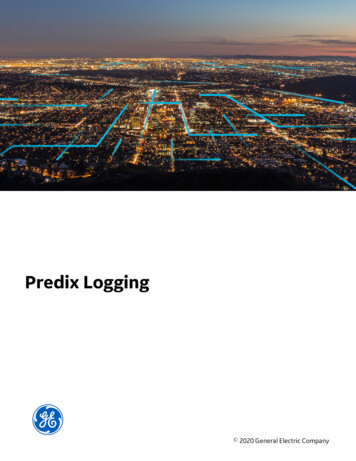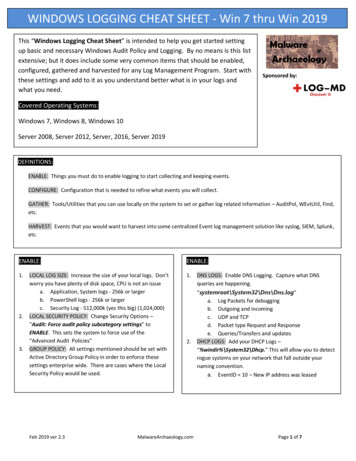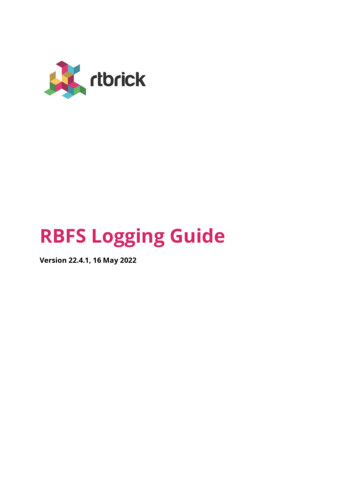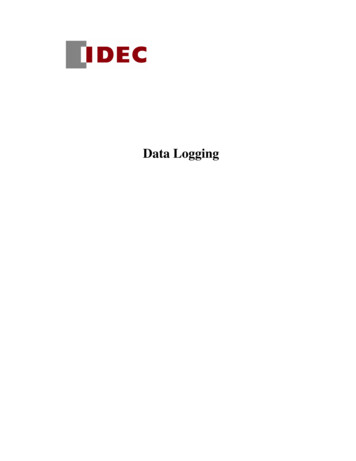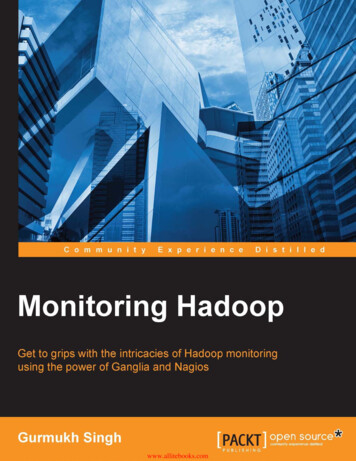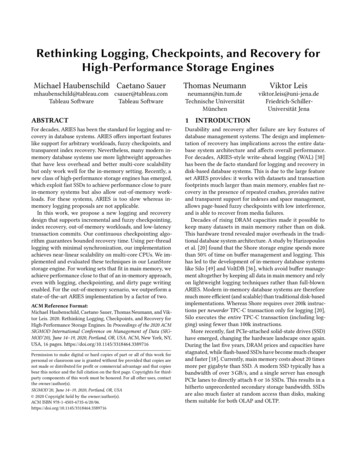
Transcription
Rethinking Logging, Checkpoints, and Recovery forHigh-Performance Storage EnginesMichael Haubenschild Caetano SauerThomas NeumannViktor Leismhaubenschild@tableau.com csauer@tableau.comTableau SoftwareTableau Softwareneumann@in.tum.deTechnische ch-SchillerUniversität JenaABSTRACT1For decades, ARIES has been the standard for logging and recovery in database systems. ARIES offers important featureslike support for arbitrary workloads, fuzzy checkpoints, andtransparent index recovery. Nevertheless, many modern inmemory database systems use more lightweight approachesthat have less overhead and better multi-core scalabilitybut only work well for the in-memory setting. Recently, anew class of high-performance storage engines has emerged,which exploit fast SSDs to achieve performance close to purein-memory systems but also allow out-of-memory workloads. For these systems, ARIES is too slow whereas inmemory logging proposals are not applicable.In this work, we propose a new logging and recoverydesign that supports incremental and fuzzy checkpointing,index recovery, out-of-memory workloads, and low-latencytransaction commits. Our continuous checkpointing algorithm guarantees bounded recovery time. Using per-threadlogging with minimal synchronization, our implementationachieves near-linear scalability on multi-core CPUs. We implemented and evaluated these techniques in our LeanStorestorage engine. For working sets that fit in main memory, weachieve performance close to that of an in-memory approach,even with logging, checkpointing, and dirty page writingenabled. For the out-of-memory scenario, we outperform astate-of-the-art ARIES implementation by a factor of two.Durability and recovery after failure are key features ofdatabase management systems. The design and implementation of recovery has implications across the entire database system architecture and affects overall performance.For decades, ARIES-style write-ahead logging (WAL) [38]has been the de facto standard for logging and recovery indisk-based database systems. This is due to the large featureset ARIES provides: it works with datasets and transactionfootprints much larger than main memory, enables fast recovery in the presence of repeated crashes, provides nativeand transparent support for indexes and space management,allows page-based fuzzy checkpoints with low interference,and is able to recover from media failures.Decades of rising DRAM capacities made it possible tokeep many datasets in main memory rather than on disk.This hardware trend revealed major overheads in the traditional database system architecture. A study by Harizopouloset al. [20] found that the Shore storage engine spends morethan 50% of time on buffer management and logging. Thishas led to the development of in-memory database systemslike Silo [49] and VoltDB [36], which avoid buffer management altogether by keeping all data in main memory and relyon lightweight logging techniques rather than full-blownARIES. Modern in-memory database systems are thereforemuch more efficient (and scalable) than traditional disk-basedimplementations. Whereas Shore requires over 200k instructions per neworder TPC-C transaction only for logging [20],Silo executes the entire TPC-C transaction (including logging) using fewer than 100k instructions.More recently, fast PCIe-attached solid-state drives (SSD)have emerged, changing the hardware landscape once again.During the last five years, DRAM prices and capacities havestagnated, while flash-based SSDs have become much cheaperand faster [18]. Currently, main memory costs about 20 timesmore per gigabyte than SSD. A modern SSD typically has abandwidth of over 3 GB/s, and a single server has enoughPCIe lanes to directly attach 8 or 16 SSDs. This results in ahitherto unprecedented secondary storage bandwidth. SSDsare also much faster at random access than disks, makingthem suitable for both OLAP and OLTP.ACM Reference Format:Michael Haubenschild, Caetano Sauer, Thomas Neumann, and Viktor Leis. 2020. Rethinking Logging, Checkpoints, and Recovery forHigh-Performance Storage Engines. In Proceedings of the 2020 ACMSIGMOD International Conference on Management of Data (SIGMOD’20), June 14–19, 2020, Portland, OR, USA. ACM, New York, NY,USA, 16 pages. https://doi.org/10.1145/3318464.3389716Permission to make digital or hard copies of part or all of this work forpersonal or classroom use is granted without fee provided that copies arenot made or distributed for profit or commercial advantage and that copiesbear this notice and the full citation on the first page. Copyrights for thirdparty components of this work must be honored. For all other uses, contactthe owner/author(s).SIGMOD’20, June 14–19, 2020, Portland, OR, USA 2020 Copyright held by the owner/author(s).ACM ISBN 18464.3389716INTRODUCTION
Because SSDs provide block-wise access, and data needsto be loaded into DRAM before it can be processed, a number of high-performance storage engines have recently beenproposed to exploit fast SSDs [7, 31, 39, 50]. Using techniques like pointer swizzling [31] and scalable optimisticsynchronization [32, 33], systems like LeanStore [31] offertransparent buffer management with very little overhead.This SSD-optimized approach is a new database architecturethat significantly differs from both the disk-based and thein-memory designs.Another potential alternative to SSDs is persistent memory. Unfortunately, the first generation of byte-addressablepersistent memory (“Intel Optane DC Persistent Memory”)is currently almost as expensive as DRAM, and is thereforenot (yet) the ideal medium for primary data storage. However, its low write latency makes it a perfect technology forpersisting the log. Therefore, for high-performance storageengines, an economical design is to store the data itself onSSD and use a small amount of persistent memory to storejust the tail of the WAL. What currently remains unclear ishow to best implement logging and recovery for this newclass of database systems.Neither of the existing approaches (ARIES or in-memory)is a good fit for SSD-optimized high-performance storage engines. Conceptually, traditional ARIES-based designs have allthe required features and are designed for the page-wise storage access, but have too much overhead and do not scale wellon modern multi-core CPUs due to the centralized loggingcomponent. State-of-the-art in-memory recovery techniques,as used by SiloR [55] and Hekaton [13, 30], have little overhead and good scalability, but are not optimized for data setslarger than memory.In this work, we propose a logging and recovery designthat is well suited for modern high-performance storage engines. It extends the scalable logging scheme proposed byWang and Johnson [52] with a novel continuous checkpointing algorithm, an efficient page provisioning strategy, andan optimized cross-log commit protocol. We integrate allthese components into LeanStore [31], a lightweight buffermanager that uses pointer swizzling and optimistic synchronization. The resulting system can sustain transaction ratesclose to that of a pure in-memory system when all data fitsin DRAM, as well as handle out-of-memory workloads transparently. Our approach has low CPU overhead, scales wellon multi-core CPUs, balances I/O overhead and recoverytime, and exploits modern storage devices such as persistentmemory for low-latency commits and PCIe-attached SSDsfor larger-than-memory data sets. It offers many of the features typically associated with ARIES, including fuzzy checkpoints, index recovery, and transaction footprints larger thanmemory (steal), but has much lower overhead than ARIES implementations used in disk-based systems. Compared to over200k instructions per TPC-C transaction spent for loggingin Shore [20], our approach requires only 15k instructions,and scales well on multi-core CPUs.The key contributions of this work are (1) a framework ofpractical techniques for all recovery- and durability-relatedcomponents in flash-optimized high-performance storageengines, (2) a logging and commit protocol that uses remote flush avoidance for low-latency transactions on persistent memory, (3) a novel design for low-overhead, continuous checkpointing that bounds recovery time and smoothlyspreads writes over time, (4) a thorough discussion of pageprovisioning in the context of high-performance buffer managers, and (5) an implementation and evaluation of our approach with real persistent memory against existing diskbased and in-memory designs, demonstrating its low instruction footprint, good scalability, and fast recovery.2BACKGROUNDThis section reviews system designs that are relevant to theapproach proposed in this paper.2.1ARIESARIES [37, 38] has become the standard logging and recoverymechanism of disk-based DBMSs. One of the cornerstonesof the ARIES design is physiological logging, which assignsa page identifier to each log record but permits logical updates within a page. Logging in such a page-oriented fashionimplies that pages can be recovered in parallel and providesa good trade-off between log volume and replay efficiency.ARIES also supports in-place updates on database storagewith a steal policy, i.e., uncommitted changes can be writtento disk. In order to remove such changes during recovery, anundo phase executes and logs compensation operations thatare the logical inverse of the operations performed duringforward processing or redo recovery. Such logical compensation steps enable record-level locking (i.e., concurrencycontrol at the sub-page level) and system transactions thatperform maintenance steps such as page splits.Physiological logging and logical undo also provide twokey benefits, the first of which is fuzzy checkpointing. Thismeans that a dirty page can be written at any time, regardless of transaction activity, as long as no physical operationsare in progress on that page—i.e., as long as appropriatelatches are acquired. Fuzzy checkpointing introduces verylow overhead on running transactions and permits constantpropagation of updates to disk, which guarantees boundedrecovery time, steady forward processing performance, andwell-balanced I/O throughput. In addition, fuzzy checkpointing makes it much easier to produce both full and incremental backups, and thus provides support for efficient mediarecovery. The second benefit is the ability to log and recover
2.2In-memory Database SystemsIn-memory database systems, in contrast to ARIES, employlightweight logging techniques. While many variations oflogical and physical logging exist (which we review in Section 5), the value logging approach used in Silo [49, 55] isthe most relevant for this paper. With value logging, a logrecord does not contain a page identifier; rather, it simplystores a logical tuple identifier and a transaction ID, alongwith the modified tuple’s contents. The main advantage ofthis approach is that it removes the dependency between logrecords of the same page, which in physiological logging isa source of additional thread synchronization during bothnormal processing and recovery.To eliminate the bottleneck of a centralized log, Silo employs distributed logging among CPU cores [28, 49, 52]. Thisapproach uses multiple log buffers, where each transactionis assigned to a log buffer (i.e., logs are partitioned by transaction) and each buffer is written to its own file without anycoordination with other threads. Since durability is guidedby epochs and a group commit protocol, recovery processingrequires establishing the maximum epoch that is persistedin every log file. Then, each log file can be replayed in parallel and in an arbitrary order, thanks to the value loggingmechanism and the use of monotonically-increasing transaction IDs (largest ID wins). Despite these advantages, valuelogging suffers from the following inherent disadvantages: itdoes not support index recovery, requires the entire data setto live in main memory, and lacks incremental checkpoints.Our approach combines the best of both worlds: the scalability and low overhead of value logging and the features ofphysiological logging.2.3CheckpointsCheckpoints in a physiological logging system require writing dirty pages to persistent storage. Unfortunately, as wedetail in Section 3.4, the state of the art has not been developed beyond the traditional disk-based techniques. Instead,recent research has mostly focused on in-memory databasesthat must write the entire database at a tuple granularity. ThisPage AccessTxn1GSN7Txn2GSN2PageA GSN1GSN increment 1 GSN8GSN7GSN91GSN9PageB GSN4(a) Same PageGSN5GSN2 GSN8 1 GSN8GSN1 1arbitrary page-based data structures, which implies that indexes can be recovered along with primary data and thusneed not be fully rebuilt during recovery.Despite all the advantages mentioned here, ARIES hasbeen deemed obsolete by many recent proposals for its excessive forward-processing overhead and lack of scalability.Unfortunately, most of these approaches (as detailed below)also forego the features and advantages mentioned here.Therefore, a key design objective of this work is to maintain the features of ARIES-style write-ahead logging withoutabandoning performance and scalability.GSN8GSN4GSN5(b) IndependentFigure 1: GSNs establish a partial order between logrecords sufficient for recovery. If two changes dependon each other, the second one will have a higher GSN(a). For independent changes, GSNs are unordered (b).paper bridges this gap by proposing checkpointing and eviction techniques that are appropriate for the high transactionrates and I/O volume made possible by modern hardware.2.4Scalable LoggingThe obvious approach for improving the scalability of ARIESis to replace the single global log with multiple logs, andassign one or a few threads to each. Thus, when transactions write log records, they do not contend on a singleglobal lock. However, on commit, a transaction has to persist the log records in other log partitions upon which theirown changes depend. When the logs are stored on HDD,or even on SSD, flushing several logs becomes prohibitivelyexpensive. Furthermore, distributed logs require additionalmeasures for correct recovery: since each log assigns its ownlocal LSN, the order in which to replay changes for a givenpage from different logs becomes nondeterministic.Wang and Johnson [52] propose a scalable logging technique that tackles both issues by exploiting persistent memory and introducing the concept of global sequence numbers(GSN). Persistent memory, which is by now commerciallyavailable (e.g., Intel Optane DC Persistent Memory), reducesthe latency until changes are drained from CPU caches topersistent storage by more than an order of magnitude. Furthermore, these flushes can be done fully in parallel.GSNs are a lightweight, decentralized mechanism whichestablishes a partial order between log records from different log partitions similar to distributed clocks [29] (alsoknown as “Lamport timestamps”). In a distributed clockanalogy, both transactions and pages act like processes in adistributed system, with log records being the events thatneed to be ordered. A transaction’s txnGSN (timestamp) isset to max(txnGSN,pageGSN) whenever it accesses a page(synchronizes its local clock). New log records (events) arecreated with txnGSN 1. When two transactions access thesame page (Figure 1a), the protocol ensures that the logrecord for the first change has the smaller GSN. On the other
3LOW-LATENCY LOGGING ANDROBUST CHECKPOINTING WITHBOUNDED RECOVERYIn this paper, we propose a holistic approach for logging,checkpointing, and dirty page writing that combines thebenefits of ARIES with those of lightweight logging techniques. In our approach, each worker thread is assigned itsown log, which eliminates the single point of contention andimproves scalability on multi-core CPUs. Log records consistof a type, page ID, transaction ID, GSN (see Section 2.4), andthe before and after image of each change. Using a smallpersistent memory buffer, transactions commit immediatelywhen they are finished, without being appended to a groupcommit queue first. We improve over existing distributedlogging schemes with a new mechanism we call RemoteFlush Avoidance (RFA), which can detect and skip unnecessary flushes in logs of other threads. Furthermore, oursystem uses a novel continuous checkpointing algorithm thatsmoothly spreads I/O over time and thus avoids write burstsand spikes in transaction latency. Compared to traditionalARIES implementations, the instruction overhead for creating log entries and writing them to persistent storage ismuch lower in our system. Finally, we support larger-thanmemory workloads, since we build our logging frameworkon top of the state-of-the-art LeanStore engine.3.1Two-Stage Distributed LoggingThe main scalability issue of ARIES is the synchronized access to the global log. Approaches such as Aether [22, 23],ELEDA [24], and Border-Collie [25] reduce contention onthe log by minimizing the time spent in critical sections, butLog Partition 1Stage 2: SSDStage 3:Log ArchiveStage 1: Persistent Memoryfree chunkscurrentchunkWAL writerworker1fullchunksLog Partition 2worker2.hand, when two transactions access distinct pages, theirGSNs are not synchronized, and the latter event can evenhave a smaller GSN (Figure 1b). Note that the full protocolalso ensures GSN ordering of log records inside each log,which we omitted from Figure 1 for simplicity. During recovery, log records for a page are gathered from all individuallogs, and sorted by GSN before they are applied.For durability, Wang and Johnson propose passive groupcommit: When a transaction commits, it first flushes its ownlog and then waits in a group commit queue. Once all otherlogs are durable up to the transaction’s commit record GSN,its commit is finally acknowledged. This design effectivelysolves the scalability issue for logging, and indeed we use itas the basis for logging in our system. However, its implementation in Shore-MT still suffers from high instructionoverhead, has unnecessarily high transaction latencies andrelies on a custom kernel module. For reference, the reportedTPC-C throughput [52] with 40 threads is below what oursystem achieves with a single thread (26k vs. 41k txn/s).Log Partition nworkernFigure 2: Overview of two-stage distributed logging.with a large-enough core count, the single log still becomesthe scalability bottleneck. Therefore, in our system, eachworker thread has its own separate log as shown in Figure 2.Every transaction is pinned to a worker thread, so that itslog records are all written to exactly one of those logs. Different transactions can still operate on the same page, solog records for a certain page can end up in different logs.This design is based on the transaction-level log partitioningapproach of Wang and Johnson [52] explained in Section 2.4.The log is organized into three stages. The first stage consists of a small number of log chunks organized in a circularlist as shown in Figure 2. One of the chunks is always designated as the current chunk, which is where transactionsappend their log records. Whenever the current log chunkbecomes full, it enters the full portion of the list. From there,chunks are picked up by a dedicated WAL writer thread—alsoone for each log—which flushes them into the second stage.After a chunk is successfully written, its buffer is zeroed outand placed into the free portion of the list, from which it willeventually be picked up as the current chunk to append newlog records. Lastly, log files are archived into the third stagefor media recovery—this is shown on the left side of Figure 2.In the hardware configuration assumed throughout thispaper, the first stage resides on persistent memory or batterybacked DRAM. Thus, transactions only need to flush CPUcaches when they want to persist log records upon transaction commit, and do not have to wait for the staging of fulllog chunks to SSD. This allows for very low commit latencyand high transaction throughput without the need for groupcommit. For the second stage, SSD storage is a good candidate because it is much cheaper than persistent memory.Furthermore, SSD bandwidth is sufficient for the amountof log volume that even the fastest transaction systems canproduce.Notwithstanding the benefits of logging to persistent memory, our design is not restricted to it. An alternative solutionthat keeps the first stage in DRAM and guarantees persistence once log chunks are flushed to SSD still achieves highthroughput by employing an RFA-optimized version of groupcommit. This alternative is presented at the end of Section 3.2.
Logical DependenciesTx1Tx2ARIESLogDistributed LoggingPartition 1 Partition 2Partition nRemote Flush AvoidancePartition 1 Partition 2Partition x1)COMMIT(Tx2) global latch flushes on n partitions no contention no remote flushesFigure 3: Two independent transactions and the synchronizing operations in different logging strategies.3.2Low-Latency Commit Through RFASplitting the log into multiple partitions and pinning eachtransaction to one of those partitions allows worker threadsto create log entries without synchronization. However, toguarantee consistency all log partitions need to be flushed upto the transaction’s current GSN as depicted for “DistributedLogging” in Figure 3.Let us give an example of why this is necessary: supposetransaction Txn1 deletes a tuple on page PA and records thischange with GSN 12 in log L 1 , but does not yet commit. Thentransaction Txn2 also inserts a tuple on PA and records this inits own log L 2 . The GSN protocol mandates that this changewill be recorded with a higher GSN, e.g., GSN 13. When Txn2commits, it has to ensure that all prior changes on this pagehave been persisted in the log. It therefore needs to flush allother log partitions up to GSN 13.Profiling our system showed that these remote log flusheslead to significantly reduced scalability (see experiment inSection 4.1). Wang and Johnson’s approach [52] works aroundthis issue by using passive group commit, where transactionsonly flush their own log and are put in a commit queue.A group commit thread periodically checks the minimumflushed GSN of all logs, and sets those transactions to committed for which all necessary log records are persisted. Groupcommit is a good solution for workloads with a lot of concurrent transactions without low-latency requirements.We propose a new technique called Remote Flush Avoidance (RFA), which enables high throughput and scalabilitywhile still providing low-latency single transaction commits.The motivation for RFA comes from the observation that,for most transactions, there is neither logical conflict nordo they modify the same set of physical pages. A commitdependency is therefore not necessary. Consider the exampleshown in Figure 1b, in which Txn1 pessimistically flushes thelog of Txn2 since GSN 5 GSN 8 , despite the fact that the twotransactions modify different pages (PA and P B ). The basicdistributed logging approach fails to catch the independenceof Txn1 and Txn2 as it projects the dependency graph onto asingle time axis. In other words, it linearizes the partial ordering of GSNs back to a total ordering, and thereby sacrificessome of its scalability advantages. When two independenttransactions create log records concurrently, one of themwill unavoidably have the smaller GSN, and thus the othertransaction needs to flush it.RFA adds a few lightweight steps to the GSN protocol thatenable it to skip most remote partition flushes:(1) For each page, we remember L last , the log that containsthe record for the most recent modification of this page.This information does not need to be persisted, andcan be stored in the buffer frame for that page.(2) When a transaction starts, it determines GSN flushed , themaximum GSN up to which all logs have been flushedat that point. Any log record created afterwards isguaranteed to have a higher GSN (see Section 2.4).(3) Lastly, each transaction maintains a needsRemoteFlushflag, which is initially set to false.Whenever a transaction accesses a page (either for read orwrite), it checks if the page GSN is below GSN flushed . If thatis the case, then all previous log records of that page havealready been flushed and the page access can proceed. Otherwise, if the page GSN is above GSN flushed , the algorithmfurther checks if the committing transaction’s log is the sameas L last . If that is the case, then page access can also proceed,because it means that the last modification is from the sametransaction and thus will be flushed anyway when the current transaction commits. Only if both checks fail, then theneedsRemoteFlush flag is set to true, which causes all logsto be flushed when the transaction commits. In a nutshell,remote flushes are avoided whenever the log records of atransaction depend only on (1) guaranteed flushed changesor on (2) changes from its own log.Figure 3 summarizes the benefits of RFA. Given two independent transactions, ARIES requires synchronized access for each log record, while standard distributed loggingfrequently requires synchronization on commit. In order toavoid this, one could explicitly track dependencies, but this isprohibitively expensive as noted previously [52]. Therefore,RFA detects such dependencies without expensive bookkeeping data structures, allowing the two transactions shown inFigure 3 to commit without any synchronization.RFA and group commit are orthogonal optimizations thatcan be combined or used individually, yielding four designs.
When persistent memory is available, we argue that RFAwithout group commit is the best approach as it enables lowlatency commits. However, even in the absence of persistentmemory, RFA helps to reduce transaction latency when combined with group commit. Without RFA, group commit requires a transaction to wait on all logs to be persisted beforeits commit is acknowledged. With RFA, transactions withtheir needsRemoteFlush flag set to false can commit as soonas their own log is persisted. In this design, in addition to aglobal group commit queue, each log has its own queue fortransactions that do not require a remote flush.3.3Challenges of CheckpointingIn a broad sense, a checkpoint is any technique that aims tobring the persistent state of a database up to date in orderto reduce recovery time and recycle log space. The classicpaper by Härder and Reuter [19] provides an abstract classification of checkpointing techniques and how they relate tothe granularity of logging. Most in-memory systems writethe entire contents of a database in a transaction-consistentmanner when taking a checkpoint. To achieve that, thesesystems require shadow copies of individual tuples in mainmemory, usually in combination with multiversion concurrency control [49], or in some cases by duplicating the entire database [10]. These systems are usually slower while acheckpoint is being taken, because individual records mustbe versioned and transaction activity must halt—or at leastbe coordinated in multiple phases [45]—to establish a pointof consistency. Given these restrictions, it is advisable to takecheckpoints sparingly in such systems. However, this translates to longer recovery times, which is further worsened bythe fact that log replay is substantially slower (see Section 5).For the reasons given above, this paper focuses on pagebased checkpointing to complement our page-based buffermanagement and logging schemes. Robust page-based checkpointing is a difficult challenge in practice because it requiresfinding an acceptable trade-off between opposing goals. Inorder to bound recovery time to an acceptable level, a systemmust flush dirty pages at a rate that is compatible with therate of incoming transactions. If the flush rate is too high,this results in a waste of I/O resources and a needless increase in write amplification. On the other hand, if the flushrate is too low, the log size cannot be bounded, which canresult in service outage when the log device fills up, and longrecovery time in case of a failure. A low rate may also causethe buffer manager to be saturated with dirty pages, whichcan cause a drop in transaction throughput if insertions orqueries cannot allocate memory. Even if an appropriate flushrate is found, the checkpointer must be smart about whichpages to flush, since some dirty pages are worth flushing at alower rate than others (e.g., hot pages with frequent updates).These issues have been largely ignored in recent research,which has focused mainly on alternative architectures thatpropagate changes at record (rather than page) granularity.One good example of a checkpointing implementation intraditional WAL systems is PostgreSQL [48]. It uses two independent processes to write dirty pages: a checkpointer anda background writer. The former is responsible for boundingthe size of the log and thus recovery time; it is triggeredwhen the log reaches a certain size, or by a timeout (5 minutes by default). The checkpointer flushes every dirty pagein the buffer pool (i.e., a direct checkpoint [19]). As such, theLSN of the checkpoint log record also establishes the startingpoint of redo recovery. One problem with this approach isthat it incurs periodic bursts of high I/O activity and contention on the buffer manager data structures, leading toperformance dips. To solve this problem, the backgroundwriter is triggered at fixed time intervals and writes a certain number of dirty pages calculated from configurationparameters. Besides PostgreSQL, other approaches arguethat checkpointing should be done “periodically” [38], “everyfew seconds” [10], or “roughly 10 seconds after the previouscheckpoint completed” [55]. The inherent problem of suchtime-based polici
High-Performance Storage Engines Michael Haubenschild mhaubenschild@tableau.com Tableau Software Caetano Sauer csauer@tableau.com Tableau Software Thomas Neumann neumann@in.tum.de Technische Universität München Viktor Leis viktor.leis@uni-jena.de Friedrich-Schiller-Universität Jena ABSTRACT For decades, ARIES has been the standard for .
